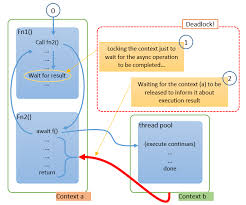Asynchronous Programming in C#
Asynchronous programming in C# allows tasks to execute independently, without blocking the main thread of execution. This enables applications to remain responsive while performing long-running operations such as I/O-bound tasks or network requests.
Async and Await Keywords: Introduced in C# 5.0, the async and await keywords simplify asynchronous programming by enabling developers to write asynchronous code in a more synchronous style.

Tasks: Tasks represent asynchronous operations and provide a standardized way to work with asynchronous code. They can be awaited using the await keyword.
Asynchronous Methods: An asynchronous method returns a Task or Task<TResult> and typically includes asynchronous operations such as I/O-bound tasks, network requests, or CPU-bound operations offloaded to separate threads.
Concurrency vs. Parallelism: Asynchronous programming enables concurrency, allowing multiple tasks to execute concurrently without blocking each other. Parallelism, on the other hand, involves executing multiple tasks simultaneously using multiple threads.
Error Handling: Asynchronous code introduces challenges in error handling, especially when dealing with exceptions across asynchronous boundaries. Techniques such as try-catch blocks and Aggregate Exception help in handling errors gracefully.
Advantages:
Improved Responsiveness: Asynchronous programming keeps applications responsive by allowing them to perform non-blocking operations, ensuring a smooth user experience.
Scalability: Asynchronous code enables applications to handle a large number of concurrent requests efficiently, making it suitable for server-side applications such as web servers.
Resource Efficiency: By utilizing asynchronous I/O operations, applications can make better use of system resources and avoid unnecessary blocking, leading to improved performance.
Best Practices:
Use Asynchronous APIs: Utilize asynchronous APIs provided by frameworks like .NET to perform I/O-bound or long-running operations asynchronously.
Avoid Blocking Operations: Minimize blocking operations, such as synchronous I/O calls or CPU-bound tasks, within asynchronous methods to maintain responsiveness.
Error Handling: Implement robust error handling mechanisms to handle exceptions gracefully in asynchronous code, ensuring proper fault tolerance and reliability.


Leave a Reply
Want to join the discussion?Feel free to contribute!